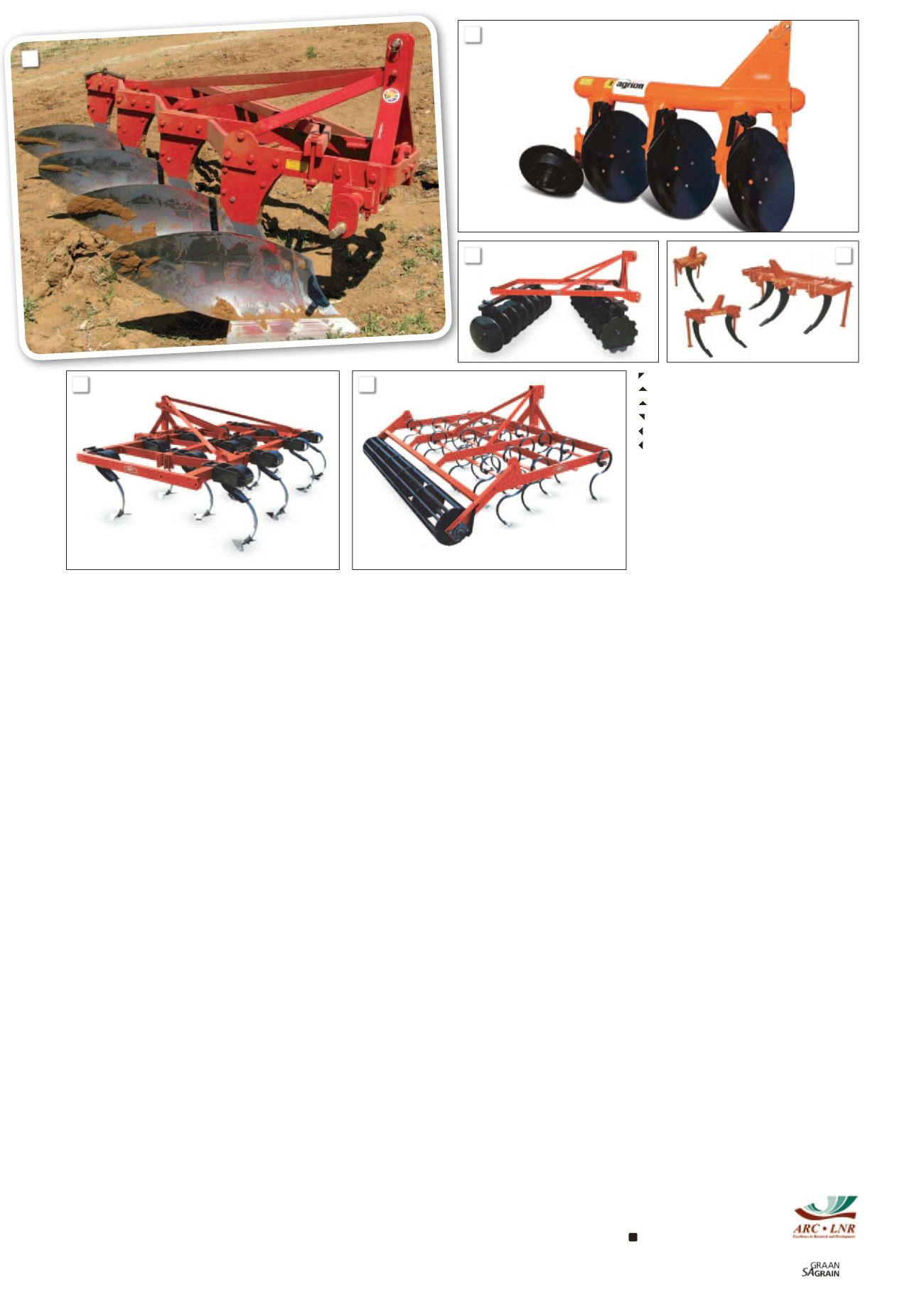

101
September 2018
Tillage implements
Tillage is the agricultural preparation of soil by mechanical agitation
of various types, such as digging, stirring or overturning. Tillage im-
plements are classified in primary tillage implements and secondary
tillage implements. Furthermore, tillage implements are also clas-
sified in conventional tillage and conservation tillage. Conservation
tillage (
Figure 2
) can also be divided into reduced tillage and no-till.
Conventional tillage practices require the most tillage operations
while conservation tillage requires less or no tillage practices.
Commonly used implements for conventional
tillage
Mouldboard plough
The mouldboard plough (
Photo 1
) is used for seedbed preparation
and forms part of the primary tillage actions. It is one of the old-
est of all agricultural implements and is generally considered to be
the most important tillage implement in conventional tillage prac-
tices. Ploughs can be categorised into mounted and semi-mounted
ploughs.
The drawbar power requirements for a four-share plough on sandy
soils will be 48 kW or 12 kW/share, at a working depth of 250 mm,
and a working speed of 5,9 km/h.
Disc plough
Disc ploughs (
Photo 2
) are most suitable for conditions under which
mouldboard ploughs do not work satisfactorily, such as hard dry
soils, in sticky soils where a mouldboard plough will not scour and
in stony fields. Disc ploughs depend on their weight to penetrate
into the ground and therefore are normally built from heavy mate-
rial. Side forces are usually taken up by the land-wheel at the back of
the implement.
The drawbar power requirement for a three disc plough at a working
depth of 250 mm is 45 kW or 15 kW/disc at a speed of 6 km/h.
Disc harrow
Disc harrows (
Photo 3
) rank close to the mouldboard plough in im-
portance as tillage implements. Heavy duty disk harrows are used
for primary tillage, for controlling weeds, and for cutting and mixing
stubble or cover crops with the soil. Lighter units are often used in
seedbed preparation subsequent to ploughing.
The power requirement to pull a light duty, 3 m cutting width disc
harrow at a working depth of 150 mm in sandy loam soil at a speed of
8 km/h, is 50 kW. The power requirement for heavy duty offset discs
with a cutting width of 3 m at 8 km/h is 80 kW.
Ripper or subsoiler
A ripper or subsoiler (
Photo 4
) is used to break through and shat-
ter compacted or otherwise impermeable soil layers and to improve
rainfall penetration. When practicing conventional tillage and using a
plough, a ripper will be used to break through the plough pan when
necessary.
The power requirement to pull a three-tine ripper on average is
60 kW or 20 kW/teeth at a working speed of 7 km/h and working
depth of 400 mm.
Cultivator
Cultivators (
Photo 5
) are used for weeding or seedbed preparation.
This specific model is called a Vibro Flex tiller, and is normally used
at an operation speed of 12 km/h to get the vibrating effect and
therefore maximum efficiency. It is also used to loosen the top layer
of soil to allow faster germination and enhance plant growth.
Depending on the working width of the implement, power require-
ments may vary from 40 kW to 100 kW.
Cultivator (s-tine with roller)
This implement (
Photo 6
) is used for light duty weeding and seed-
bed preparation. The roller at the back is used to break up the clots
to provide a fine seedbed for planting. The power needed to pull
the implement ranges between 40 kW and 80 kW, depending on the
working width.
For more information contact Dr Tingmin Yu or Johan
van Biljon at 012 842 4000.
1: Mouldboard plough.
2: Disc plough.
3: Disc harrow.
4: Ripper.
5: Cultivator.
6: Cultivator (s-tine with roller).
1
2
3
4
5
6
















